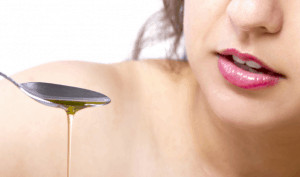Myrrh Essential Oil Health Benefits Explained: We Need More Myrrh!

Even if you’re not particularly religious (or a follower of the Christian faith to be specific), I’m quite sure that we’ve all heard the tale of the three wise men who were guided by a star to the birthplace of Jesus Christ thousands of years ago.
The story has played a pinnacle role in shaping the history of believers and nonbelievers alike and is essential to the story of Jesus and his disciples. It is said that the three wise men brought with them gifts of frankincense, gold and myrrh and we’ll soon see why the last was so important.
Myrrh was vital to the growth and establishment of ancient healthcare practices and its use for medicinal purposes has been dated back as far as 3000 years to ancient India, where Ayurvedic monks used the sap of the myrrh tree as a tonic or burned it as a form of incense in order to relieve head pains, infections as well as rheumatic pains and other issues related to the nervous system.
It’s important to note that the Ayurvedic system of medicine (which gave us oil pulling!) is the oldest known to man, so one could say that myrrh was definitely one of the critical components in shaping our understanding of how to treat illness disease.
However, it was the ancient Chinese who really managed to utilise the sap of the myrrh tree to the best of it’s ability (at least during ancient times) and used it for a variety of issues. They managed to use the resin as a tonic to treat the liver, heart, spleen and even the uterus.
In fact, a lot of the research that was discovered by the ancient Chinese with regards to myrrh and it’s properties has lasted well into the modern era and has only changed slightly with the advances in modern science and medicine. It just goes to show that some wisdom’s are set for more than a lifetime. Myrrh is often used with a variety of other herbs, spices and essential oils to maximise its healing properties.
What Is Myrrh Essential Oil?

Myrrh tree.
The myrrh tree is common to most parts of Northern Africa and areas in the Middle East. They often grow in dry, arid regions and can be identified by their curled and knotted root systems. They’re tough and hardy trees and take well to most soil types – this also makes them suitable for large-scale cultivation.
The myrrh itself comes from the resin of the tree, which is essentially contained in the layer just under the bark and is also referred to as the sap of the tree. Myrrh, much like frankincense (the two are often used together for their immense healing properties) is drawn from the tree by wounding or cutting into the bark and allowing the sap (or resin) to run from the wound.
The resin coagulates, or dries, quite quickly once it’s exposed to air (especially dry air in the desert). The dried resin form tear which scraped from the bark of the tree and shaped into nodules or beads. This is the common raw or natural form of myrrh and is quite bitter – in fact, the term ‘myrrh’ is derived from the arabic term ‘murr’ which means bitter.
From here, the hardened beads of resin are turned into myrrh essential oil through a method known as steam distillation. In this process, the beads are crushed with a stone or hammer to form a fine powder. This powder is then placed in a container; water is heated in a separate container in order to create steam which passes through a tube and fills the chamber containing the powder.
Through the method of evaporation, the essential nutrients, vitamins and various chemical compounds that make myrrh so potent are extracted from the organic material and form a vaporous cloud. This vapor then passes through another tube and winds up in a final chamber where it cools and forms droplets that gather at the base of the chamber. This final liquid is the distilled essential oil of the myrrh.

Myrrh.
The steam distillation method is one of the oldest known to man and is very effective in removing any impurities from the original matter. It also produces the highest grade or quality of oil. The two active chemicals in myrrh that make it so effective for healthcare and medicinal purposes are known as terpenoids and sesquiterpenes.
These are found in a variety of fruits, vegetables and herbs and often contribute to their antimicrobial and antiseptic qualities as well as strengthening their natural antioxidant content. These are what make myrrh such an effective treatment for internal infections (as the antioxidants help to remove any toxins in our bloodstreams) as well as killing off any bacteria that may linger on the surface of our skin and cause any irritation or possible infection of open wounds etc.
I highly recommend myrrh for a variety of ailments in different scenarios. It’s great for treating wounds, fevers and stomach bugs. Myrrh has also famously been mixed with wine to form a rather potent natural analgesic – that is, a natural pain reliever. If you’re not up for wine, I could also recommend mixing it with some honey, lemon, and cinnamon to make a very healthy natural tea, that has similar pain-relieving properties.
Top 5 Uses For Myrrh Essential Oil
[Please note that this list is in nor specific order of importance or objective rank. These are just the top 5 recommended uses for myrrh that I would suggest.]1. Myrrh Essential Oil As Mouthwash

Myrrh essential oil as mouthwash.
Having a clean mouth is an essential part of good health as throat infections and abscesses can really ruin a day and often lead to costly medications or doctors’ appointments. In fact, it is known that the human mouth holds more germs than most animals – making our bite, one of the most dangerous in the animal kingdom. A scary realization!
This makes mouth hygiene all the more important to achieve and maintain. Usually, most standard mouthwashes or toothpastes are effective in keeping your mouth relatively clean, but they often leave your mouth feeling dry and can even burn at times.
I recommend mixing a few drops of myrrh essential oil with peppermint oil, tea tree essential oil or eucalyptus essential oil, a little cinnamon and a few drops of lemon juice with some warm water to make a highly effective, natural mouthwash that kills off all the germs in mouth and freshens your breath without the downsides of cotton-mouth or a dry tongue. It’s really effective, tastes pretty good and will definitely give you a smile worth showing regularly.
2. Myrrh Essential Oil For Oil Pulling
Oil pulling is not unlike using a mouthwash – it’s just an extended form of rinsing and can be done to rid your mouth and throat of a whole list of harmful toxins and bacteria that lead to whole heap of internal problems. In fact, scientists have concluded that about 90% of heart attacks are caused by or related to pathogens that occur in your mouth – which is quite an amazing fact in actuality.
The correct process of oil pulling is really a very simple one – even easier than using a mouthwash. It’s just a lengthier process and should be done over the course of your morning routine i.e. showering and dressing.
To do this correctly, simply add two drops of myrrh oil to a tablespoon of coconut oil and rinse your mouth with the mixture for 20 minutes. That might sound like a long time, but if you do it in the shower and while you’re getting dressed – it’ll seem a lot shorter.
This basically strengthens your gums, helps to remove any plaque that can lead to tooth decay and also kills off any germs that linger in your mouth and lead to infections. It’s important to repeat this process 4 times a week and to make sure that you DO NOT swallow the oil.
3. Myrrh Essential Oil For Hair

Myrrh essential oil for hair.
Myrrh essential oil is wonderful for treating hair and can be mixed with orange essential oil or almond oil for maximum effect. The oil helps to stimulate the sebaceous glands under your skin which makes them produce oil. This can be effective in relieving your scalp of dryness and irritation that generally causes or leads to dandruff.
The oil also penetrates deep into your scalp to increase pore tightness and stimulate hair growth – as well as allowing essential nutrients and vitamins to reach your hair follicles making them stronger, and adding natural volume to your hair and your hair has more grip, so won’t fallout as easily. For the best effects of this oil, I recommend a hot oil treatment.
To do this, simply heat 4-5 drops of myrrh and 2 drops of peppermint essential oil with a suitable carrier oil (olive, canola or coconut oil) and stir so that they blend. Note that the oil should be allowed to cool so that it is warm, but not hot to the touch – oil burns can be really severe, so be careful here! Now, apply the oil to the tips of your fingers and massage it into scalp, working your way from the bottom of your hair to the ends.
Once you’ve coated your hair, wrap a towel or plastic wrap around your head and allow the oil to soak in for at least 30 minutes to an hour. Once the time has elapsed, simply rinse your hair out with a normal herbal shampoo or conditioner and voila! You’ll notice the amazing effects after just the first wash – but I recommend doing this at least 2 – 3 times a week for the best results.
4. Myrrh Essential Oil For Healing Wounds
Myrrh has been used in combination with frankincense through history to treat a wide variety of superficial ailments, such as wounds, sores, rashes and general inflammation or redness on the skin. Myrrh has a high sesquiterpene and terpenoid content which makes it a strong natural antioxidant and antiseptic agent.
This means that it can be applied topically by itself, or mixed with other essential oils or carrier oils, to help wounds heal faster and kill off or remove any bacteria from the area. By massaging myrrh into your skin, you stimulate the the coagulation of the blood cells which means that they harden and start to clot – essentially allowing your wound to heal faster. The analgesic qualities of the oil will also help to alleviate any immediate pain caused by the wound – so no need for additional chemical pain killers.
5. Myrrh Essential Oil For Acne Treatment

Myrrh essential oil for acne treatment.
Many of the same qualities that apply to treating your hair and skin apply to treating acne sores and scars. Some of the most important qualities of any acne treatment are antiseptic and antimicrobial agents that help to reduce and ultimately remove infections that may occur on the surface of your skin.
However, it is important for me to state that myrrh essential oil naturally stimulates your sebaceous glands, which result in your skin releasing more oil. So, although it has a relatively low comedogenic rating – and won’t physically clog up your pores itself, it will lead to excess oil being produced by your skin (especially if you have a naturally oily skin type) which could lead to pore blockage and further blemishes.
I recommend utilising myrrh essential oil with peppermint, orange or thyme essential oil and applying the mixture to your face via a clean cotton swab. The combination of oils will help to cut through the oil on your skin and clear out any dead skin cells or debris in your pores.
The natural cicatrisant nature of the oil also helps to seal your pores and tighten your skin, helping to alleviate pore blockage in future. It’s important to remember that you must rinse your face with warm water after applying the myrrh oil and pat dry with a clean towel.
Read our John Frieda Review, Body Shop Review and Nexxus Review while you’re here at Maple Holistics!
Conclusion
Myrrh has been a popular part of medicine and alternative healing techniques for thousands of years. Unlike many strange and somewhat outlandish forms of medicine that were proven ineffective – or simply absurdist with the advances of modern medicine and scientific understanding that we have today, myrrh and it’s healing properties have stood the test of time and is still recommend for a variety of ailments in today’s society.
In fact, many are turning to alternative forms of medicine as a means of resisting the often harmful side-effects that come with today’s advanced chemical treatments – and I don’t blame them.

